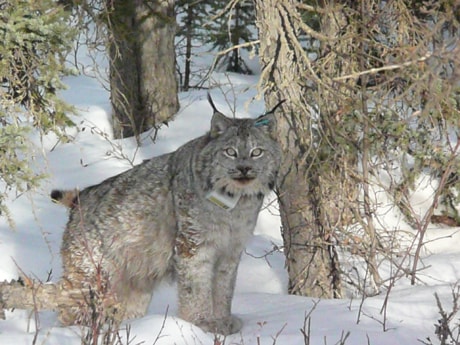Wherever the snowshoe hare lives in Alberta, the Canada lynx likely isn’t far behind.
As a specialist predator, up to 90 per cent of the wild cat’s diet is hare.
Over the centuries, a cycle has developed in which every 10 years when the hare population explodes, breeding accelerates among lynx. And when the number of hares plunge between the 10-year peaks, the lynx population likewise falls.
A recent disruption in the cycle in the southern territory for lynx (from Rocky Mountain House into the American states bordering Canada) has researchers looking for an explanation.
Gabby Yates, PhD candidate with the University of Alberta, with the assistance of her husband Seth Yates, is leading an investigation in the Nordegg area to see if the cause is habitat fragmentation as the result of human activity or climate change.
She said the lynx-hare cycle is the “heartbeat” that echoes throughout the forest.
“There’s other cycles, but none as extreme and certainly not as regular. It’s a very famous kind of process that primarily happens in Canada in the boreal forest,” Yates said from her field office in Nordegg.
Changes to that cycle will have repercussions for other species by eliminating the regular peaks of wildlife abundance. And that could cause a chain reaction, she said.
“If that cycle changes, it will have an impact on the other species in that area and it gives us a warning sign that things are probably going to start changing further north if we don’t do something,” Yates said.
Her research Project Lynx involves putting GPS (global positioning system) collars on lynx to track their movements via satellite technology.
New technology, only available since the study started in 2008, has allowed GPS collars with satellite download to be small enough for animals like a lynx.
Field work is happening in the central Eastern Slopes of the Rocky Mountains, along the foothills and mountain forest region west of Nordegg and the surrounding area.
The slopes are densely forested and since it’s mostly provincial Crown land, uses include forest production, trapping, outdoor recreation, and oil and gas well sites.
Since November 2008, eight lynx have been caught in box traps, immobilized with a drug, collared and released.
Her goal is to collar 20 lynx to gather GPS data to analyze alongside weather and trapping data, and satellite maps to show changes to habitat.
She also gathers DNA samples to determine if lynx are travelling around Alberta and British Columbia and breeding.
So far, the cats aren’t what she expected.
“They’re not banging around the cage. If you were dealing with a wolf or a cougar or any other carnivore, they would be actively trying to get out.”
Once caught, lynx realize they cannot get out of the box cage, they sit down, eat the beaver bait and wait to be released.
But they are still wild animals, she warned.
“They have very large claws and very large teeth that are very effective at hunting.”
Between nine and 16 kg (20 and 35 pounds), lynx in the Nordegg area are bigger than most house cats, but some fat, domestic felines may be comparable in weight.
And like their domesticated relatives, lynx like their cat naps. Lynx roam mostly in the afternoon and from midnight to early morning.
As a small carnivore, living on a diet of mostly snowshoe hare, lynx have no use for humans.
“(People) just pose a threat and lynx just completely avoid them.”
They are very secretive and don’t go into cities so usually they’re only spotted when they cross a country road — if people know what to look for, Yates said.
“You might think you’re seeing a coyote or something. If you can take a look at the tail, you can see that it’s just a short little stump. And they have a very unusual gait. It kind looks like their back legs are little longer then they’re front. It kind of looks like they’re tilted.”
Yates’ last catch was two lynx on Jan. 21. She collared one of them a year ago and changed the batteries in its GPS collar.
Because of the animal’s size and temperament, Yates and her husband work as a pair and don’t need a large crew to collar lynx.
Apart from their taste for hare, lynx are also known for their ability to travel great distances. In January, a local trapper caught a seven-year-old lynx with a collar put on by the Colorado Fish and Wildlife.
“It took three years for it to travel 2,500 km up the Rocky Mountains and ended up in Nordegg. That’s the longest dispersal on record.”
Lynx disappeared from Colorado in the 1970s and were reintroduced about 10 years ago.
Lynx have the distinction of being “the most highly mobile land mammal” and they are driven to roam by their search for snowshoe hare, she said.
The cats are known to regularly travel 1,500 km in a single journey.
In the U.S., lynx are already an endangered species, but the Canadian population is doing well despite the change in the 10-year cycle happening south of Rocky Mountain House, she said.
Information from Nordegg study and two similar GPS studies happening on the Washington/British Columbia border and the Montana/Alberta border will be compared to try to figure out what is stopping the world-renowned 10-year cycle.
“We are changing in the boreal forest and we don’t really know what those changes will ultimately mean. But it’s useful for us to understand what we’re doing so that if it’s important enough to change, we can.”
Yates is seeking grants to continue the project for another two years.
For more information about the project, go to www.ualberta.ca/~gyates/projectlynx/
Gabby and Seth Yates will also speak about the project at Kerry Wood Nature Centre on Feb. 25 at 7:30 p.m.
Admission is free. The presentation is sponsored by Red Deer River Naturalists.
szielinski@www.reddeeradvocate.com
